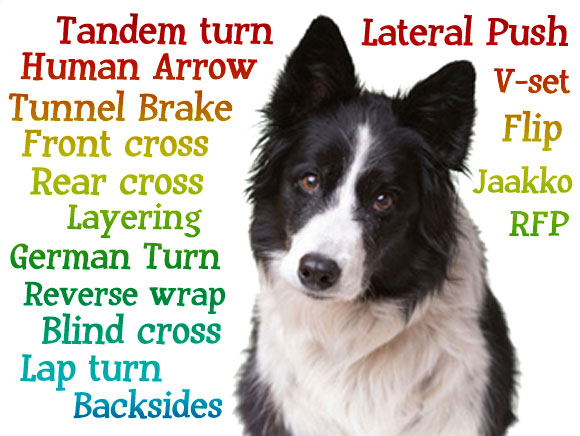Evaluating Agility Seminars – Prepare to get the best Value
 When you start getting serious about your agility performance, training opportunities will pop up from all directions. Online classes, private lessons, seminars, workshops, camps and more! All your agility friends want to go and you start catching that contagious feeling of excitement. You wistfully imagine this event provides the elusive magic wand that fixes all your agility troubles. Or, if you are more realistic, you at least hope to gain some more tools in your toolbox. Dreaming of that perfect performance in the ring because of instruction you received from an internationally known trainer, can be a very powerful motivator.
When you start getting serious about your agility performance, training opportunities will pop up from all directions. Online classes, private lessons, seminars, workshops, camps and more! All your agility friends want to go and you start catching that contagious feeling of excitement. You wistfully imagine this event provides the elusive magic wand that fixes all your agility troubles. Or, if you are more realistic, you at least hope to gain some more tools in your toolbox. Dreaming of that perfect performance in the ring because of instruction you received from an internationally known trainer, can be a very powerful motivator.
You check your schedule, you arrange your finances, embark on a new learning adventure.
But somehow you come home disappointed. What went wrong? Were you unhappy with the instructor, or the host? Maybe you just needed more preparation in the decision making phase to pick the right seminar for you. How do you increase your probability of success next time?
Gather details to make an informed choice
Thorough research ahead of time will greatly reduce the chances of feeling disillusioned. Having realistic expectations can make a big difference in how you approach your next training opportunity.
The Trainer
Is this trainer someone you can relate to in the way they train and handle their dog. If they practice something very different from your own methodology, you must be prepared to be open-minded, willing to try something outside of your comfort zone. Be sure to do some research via Youtube and Google. Check out their own personal website. If you know someone that’s attended some of their seminars, they will be a valuable resource.
The Price
Whether or not the seminar is costly is relative to your available agility funds. If money is generally tight, any cost for a seminar can seem high. If your luxury budget is open-ended, then you obviously will not have as big a problem here. Most times how you feel about the money ends up being relative to how you felt about the information you gained during the seminar. Even if you don’t agree with 100% of what was taught, if you walk away with a new understanding or new approach to a problem, that can make it worthwhile to YOU.
Time spent learning
The range in how long these seminars are is quite variable. There are muli-day camps, all day workshops, half day and some an hour or two. You will want to find out how many hours it will last. Sometimes the seminars are heavy on the individual training and sometimes they are heavy in the lecture. Usually, there’s a mix of the two. This is an important factor. If you are paying for an auditing spot, you’ll enjoy more emphasis on the discourse. If you are paying for a working spot, you’ll appreciate a more individualized presentation. Also, regarding working time, how is it counted? Do they time it? or is it an estimate by the trainer? How many breaks will there be and is there a lunch break? Many times you will get valuable information during the discussion that you implement during the working portion.
Attendees play a factor
How many people are expected to register for working spots? Some trainers have a set time per person, no matter how many show up and some will train for the full amount of time, dividing evenly between however many participants. Ask the host what is the max limit on registration. If they are a very popular, in-demand trainer, spots will likely fill up quickly. Auditing can be a good way to learn the same principles without the cost of a working spot. But keep in mind that if the trainer is spending most of the time with individuals and their personal goals, you may not be able to observe as well as a lecture. Also, there is another factor at seminars that can detract from the auditing aspect. Sometimes the other attendees like to chat among themselves while waiting for their turn. This can make it very difficult to hear and concentrate on what the instructor is saying.
 Handler and Dog skill level
Handler and Dog skill level
Seriously one of the biggest things you can do for yourself is understanding where you are personally in your own training. If you are still competing or training at Beginner level courses, it would be a pretty accurate assumption that the class on “International Handling” is way out of your league. Signing up for a class that’s over your head will be extremely frustrating. You cannot expect the host or trainer to assess this factor either. Unfortunately, occasionally you will find a host that is more concerned about filling their spots than making sure everyone has a good experience. They may say whatever it takes to get you to sign up. Use your best honest self-evaluation of where you are now. Frankly, just the language barrier can be difficult when entering a class above your skill set. As you move up in skills so does your “Agility Vocabulary”. Of course, you want to be challenged, but a class that’s way above your current ability will not only make it frustrating for you and your dog but can also be trying for the instructor and other students. If you are in doubt, if you have one, ask your regular instructor to help you assess which class would be appropriate for you and your dog.
Travel time, cost and other variables to consider
Do you have added cost associated with attending? Obviously, those things have to be figured into the value to cost ratio. Gasoline, airfare, hotel, and food expenses need to be considered in order to get an accurate assessment. Some seminars provide a meal, snacks, and drinks, which is nice.
Additional factors to take into consideration:
- How skilled is the instructor and how much are they in demand? Typically their level of competition will have a large impact on their demand, but not necessarily on their teaching ability.
- Where will you be training? An outside arena can be subject to harsh weather. Hot or cold extremes is no guarantee that it will be canceled and you get your money back. Likely the opposite, because the expense has already been incurred by the host. They will need to carry on regardless. An indoor arena may be a better bet, but possibly more expensive due to the added cost of maintaining a building.
- Lighting, footing, and accessibility are factors that may play a role in your decision-making process and the cost that has to be passed along by the host.
 Equation for Cost to Value Ratio
Equation for Cost to Value Ratio
So here comes the brain-strain, figure crunching, purely cost/time analysis.
- You start with the basic figures of Cost, Length of Time, Number of Participants.
- Take your overall time minus breaks, lunches, or other expected non-working time (I found it helpful to convert the time figures to minutes instead of hours and minutes)
- Divide the remaining time by participants. This will give you an estimate of the most time you could potentially expect to work one-on-one during this seminar. Usually, the figure would be a little lower allowing for any lecture at all.
- Then to get an apples-to-apples figure, divide the cost by the expected minutes to work and you then have a cost per minute amount to compare to your other training opportunities. I also used this per minute figure to create an hourly rate (x60) and an hourly rate per person (x60/participants)
Comparison Evaluation Chart
The numbers used in the chart below are from actual events. It is an illustration of how to compare the information you gather. Of course, as mentioned at the outset, seminars and how you end up estimating their value afterward is often more relative to the usefulness of the information.
Personal Observations
I found it interesting that I already felt that I was getting a great value from my weekly class. This chart proves that without a doubt with a 1.07 per minute cost as compared to a 3-hour seminar at 6.00 per minute. I also have come to realize, for me, if I don’t work at least 30 minutes at a seminar, I don’t feel like it’s worth the cost and effort to attend. Especially if it involved added travel expenses. So that doesn’t really relate to money at all. But I do like being able to see an apples-to-apples type comparison.
Each person has to make these choices based on their own particular personality and circumstances. I hope this was helpful for anyone looking to get the most out of a new exciting agility training opportunity.
Agility Training Comparison Chart |
|||||||||
| COST | LENGTH OF TIME OVERALL | NON-WORKING MINUTES* | PARTICIPANTS | EXPECTED WORKING TIME PER PERSON | COST PER MINUTE | PER HOUR RATE CLASS | PER HOUR PER PERSON | ||
| $60.00 | 3 | hours | 15 | 4 | 41.25 | minutes | $1.45 | $87.27 | $21.82 |
| $100.00 | 4 | hours | 45 | 8 | 24.38 | minutes | $4.10 | $246.15 | $30.77 |
| $125.00 | 2.5 | hours | 30 | 7 | 17.14 | minutes | $7.29 | $437.50 | $62.50 |
| $150.00 | 3 | hours | 30 | 6 | 25.00 | minutes | $6.00 | $360.00 | $60.00 |
| $160.00 | 8 | hours | 120 | 12 | 30.00 | minutes | $5.33 | $320.00 | $26.67 |
| $180.00 | 8 | hours | 120 | 12 | 30.00 | minutes | $6.00 | $360.00 | $30.00 |
| $200.00 | 5 | hours | 45 | 6 | 42.50 | minutes | $4.71 | $282.35 | $47.06 |
| $800.00 | 32 | hours | 480 | 12 | 120.00 | minutes | $6.67 | $400.00 | $33.33 |
| Additional Comparisons, private lessons, weekly classes | |||||||||
| $20.00 | 1.5 | hours | 15 | 4 | 18.75 | minutes | $1.07 | $64.00 | $16.00 |
| $60.00 | 1 | hours | 15 | 1 | 45.00 | minutes | $1.33 | $80.00 | $80.00 |
| $62.50 | 1 | hours | 10 | 2 | 25.00 | minutes | $2.50 | $150.00 | $75.00 |
| $15.00 | 1 | hours | 15 | 8 | 5.63 | minutes | $2.67 | $160.00 | $20.00 |
| *Non working minutes refers to any kind of down time. Breaks, lunches, late start, distracted students, bar setting etc. | |||||||||


